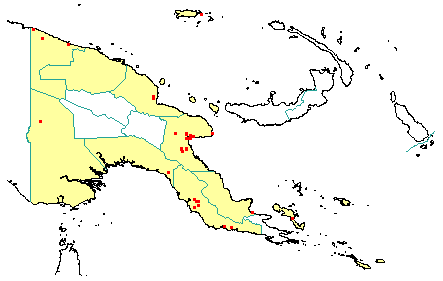
in PNGplants database
PNGTreesKey – Tristiropsis acutangula Radlk. |
Barry Conn (NSW) & Kipiro Damas (LAE).
Guide to trees of Papua New Guinea
Copyright held by the authors, National Herbarium of New South Wales, and Papua New Guinea National Herbarium
Sitzungsberichte der mathematisch-physikalischen Classe der K. b. Akademie der Wissenschaften zu München Vol. 20: 248 (1890)
Other Literature: P.W. Leenhouts, Flora Malesiana, Series 1 743-745 (1994) Fig. 82 (d & e).
Family: Sapindaceae
Dicotyledon
Timber Group: Minor hardwood
Field Characters: Large canopy tree (up to 35 m high, rarely to 53 m); Bole cylindrical (up to c. 50 cm diam.); straight (bole up to 30 m long); buttresses buttresses present (buttresses mostly up to 1 m high, sometimes to 3 m); spines spines absent; aerial roots aerial roots absent; stilt roots stilt roots absent; Bark dark brown, slightly rough or mostly smooth, slightly pustular, lenticels rounded/swelling (numerous); Subrhytidome (under-bark) red; less than 25 mm thick, 6.0-8.0; bark blaze consisting of one layer; faintly to non-aromatic; outer blaze yellow (pale (straw-coloured) or pale pink, markings absent, granular without splinters; inner blaze yellow (pale (straw-coloured) or pale pink, markings absent, granular without splinters; bark exudate (sap) absent; terminal buds not enclosed by leaves.
Indumentum: Complex hairs absent; stinging hairs absent; mature twig indumentum (hairs) present, hairs dense to sparse.
Leaves: Leaves spaced along branches, spiral (leaves occurring singly at a node and arranged spirally up the branchlet), compound (a leaf made up from two or more leaflets); petiole present, not winged, attached to base of leaf blade, swollen (at base); leaves pinnate (unbranched with more than three leaflets); petiolule not swollen to swollen (slightly (at base); rachis present, absent, absent; leaves without a terminal leaflet (the number of leaflets even - paripinnate), broadest at or near middle to broadest below middle, 5.0-18.0 cm, (1.5-) 2.0-8.0 cm, leaflets opposite, symmetric; venation pinnate, secondary veins open, not prominent, but visible, intramarginal veins absent; leaves lower surface pale green, upper surface green, indumentum (hairs) absent to present (in axils of secondary veins and mid-vein of lower surface), indumentum (hairs) dense to sparse; absent; domatia absent to present, scattered along midrib (hairs in axils of secondary veins and mid-vein of lower surface appearing like domatia); stipules absent.
Flowers: Inflorescence axillary, flowers on a branched axis, cones absent; flowers bisexual, stalked, flowers with many planes of symmetry, 2.5-3.5 mm long, diameter small (up to10 mm diam.) (c. 3 mm diam.); perianth present, with distinct sepals and petals whorls, inner perianth white or pale yellow or cream-coloured; 5, free; stamens 8 (c.), present, free of each other, free of the perianth; ovary superior, carpels joined (when more than one), locules rarely 3-5; styles solitary, 1.
Fruits: Infrutescence arranged on branched axis, fruit 20.0-30.0 mm long, dark yellow, green, or brown, not spiny, fleshy, simple, indehiscent, drupe; seeds 1, much more than 10 mm long, not winged, broad (as wide as long), seed more than 10 mm diam.
Distribution: West Sepik, East Sepik, Madang, Morobe, Western, Gulf, Central, Northern, Papuan Islands & Manus.
 | Botanical records in PNGplants database |